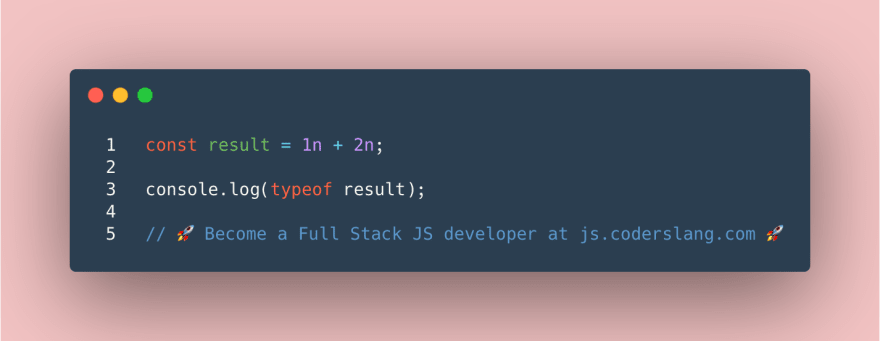This content originally appeared on DEV Community and was authored by Coderslang: Become a Software Engineer
What happens if we add an n suffix to a regular number in JavaScript? What’s the output?
.
.
.
.
.
.
.
.
.
.
.
.
.
.
.
.
.
In the first line we try to add two numbers. These aren’t regular numbers, but rather two instances of BigInt — special objects that are used to safely represent numbers bigger than Number.MAX_SAFE_INTEGER.
There are two ways to create BigInt:
- add a suffix
nto any number in JavaScript
const big = 1000000n; // 1000000n
- call the constructor
BigInt(val)and pass in a numerical value
const bigN = BigInt(123) // 123n
This value doesn’t have to a number. I can be a string.
const bigS = BigInt("234") // 234n
You can also use hex and binary notation.
const bigHex = BigInt("0xffffffffffffffff") // 18446744073709551615n
const bigBin = BigInt("0b111") // 7n
The BigInt numbers behave just like the regular ones. By adding 1n and 2n we get 3n. This is BigInt as well, and typeof 3n returns a string bigint, which will be logged to the screen when we call console.log.
ANSWER: The n suffix turns a regular JavaScript number into a BigInt. The string bigint will be logged to the console.
This content originally appeared on DEV Community and was authored by Coderslang: Become a Software Engineer
Coderslang: Become a Software Engineer | Sciencx (2021-05-31T15:51:14+00:00) JavaScript Interview Question #44: Number vs BigInt in JS. Retrieved from https://www.scien.cx/2021/05/31/javascript-interview-question-44-number-vs-bigint-in-js/
Please log in to upload a file.
There are no updates yet.
Click the Upload button above to add an update.

